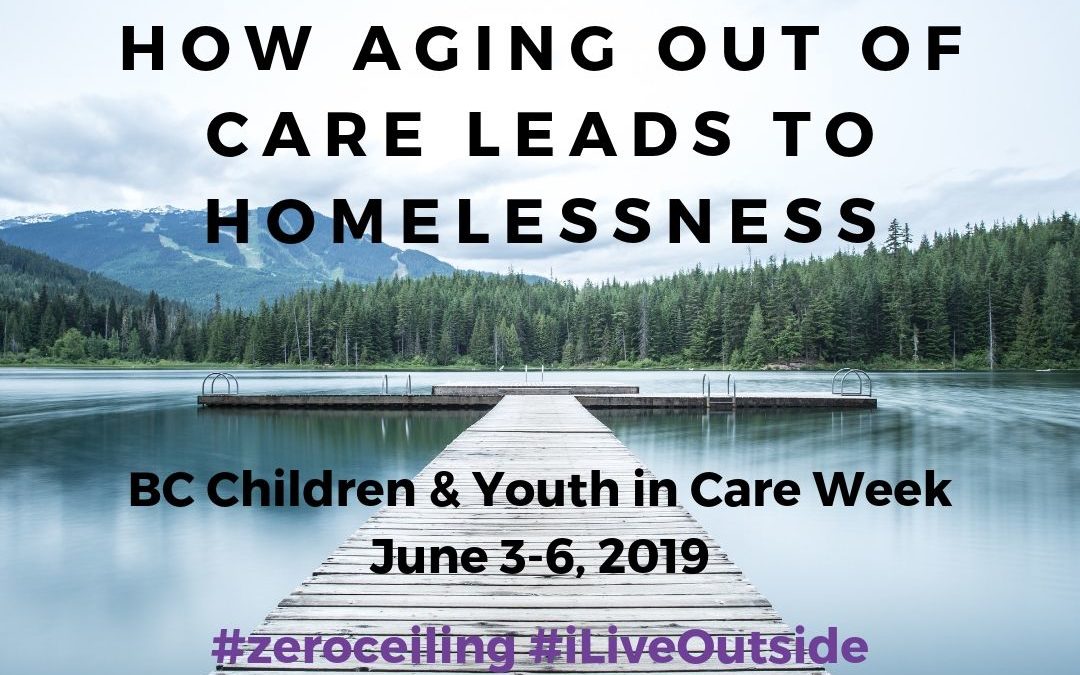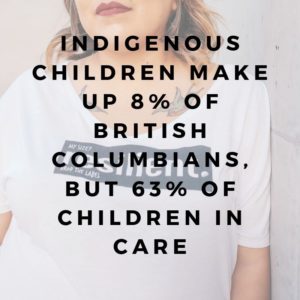This week is BC Child & Youth in Care Week. We are so grateful to the many families who open their hearts and homes to children in care and make a profound, positive difference in young lives. But what happens when this care stops? In this post, we are exploring the problems facing the 1,000 youth in BC this year who will age out of care on their 19th birthdays.
For most young Canadians, turning 19 is exciting. They typically celebrate with friends, family, and their first (legal) trip to the casino. They’ve probably been dreaming about this day for years. Many have just begun post-secondary education, or will be starting soon. Some might still live at home or with friends. Perhaps they have jobs, partners, or a crappy car. Maybe they’re taking some time to find themselves; to travel, to work, or to volunteer. It’s a time when many are discovering who they are and learning how to live independent lives.
This isn’t always the case for youth under the care of the Ministry of Children and Family Development (MCFD) in BC — i.e. foster care, group homes, or through an emancipation arrangement. For a child in care, all support ceases the day they turn 19. Many are forced to leave their home and figure it out on their own. This is known as “aging out”. And in BC, aging out means higher rates of homelessness, addictions, dependence on social assistance programs, mental health concerns, and death.
Read: “B.C.’s child welfare system has failed youth who age out and must change: coroner” from the Vancouver Sun
Aging Out in BC
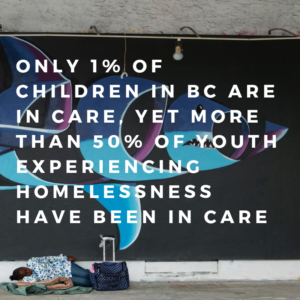
Only 1% of children in BC are in care, yet more than 50% of youth experiencing homelessness have been in care
Although only 1% of children and youth in BC are in government care, over half of youth experiencing homelessness have been in care. Young people leaving care are more likely to have not completed high school, and to suffer from mental health concerns than others their age. And shockingly, youth who have aged out of care are five times more likely to die.
In BC, at least two young people age out of care every day. And at that point, all supports formerly provided by the MCFD stop. Access to social workers, funding, their healthcare providers, a place to live — everything is gone.
Often, these teens have not been given adequate coping skills, nurturing supports, or preparation during their time under the MCFD’s protection. This leaves them at a huge disadvantage for being able to handle the transition. Some aren’t even aware that they will be told to leave until the day they turn 19.
The BC government recently committed to doing more to help youth aging out of care. They announced that they will waive post-secondary tuition for people who had previously been in care. They also increased funding and the age limit to 27 for the Agreements with a Young Adult (AYA) program. AYA offers a stipend to youth formerly involved in care, which can subsidize the costs of housing, childcare, tuition, and healthcare. But it is currently only available to those enrolled in drug/alcohol treatment, education, or other approved training. Barriers to these programs are high, and only a small portion of people who qualify actually apply and receive support.
Read: “Youth from care 5X more likely to die than the general population, BC Coroners Service Report” from FosteringChange.org
Aging Out and Homelessness
There are often very few options for youth who age out. Many do not have an extensive support network they can turn to. Most have underdeveloped life skills because of the limitations of the care system. This is often made worse by experiences of trauma, abuse, disrupted care, and the stigmas associated with being a former “foster kid”.
Much has been said about the housing crisis in Vancouver and the Sea-to-Sky corridor. With nearly 40% of twenty-somethings in Vancouver residing with a parent, it is becoming more difficult for young adults to survive without leaning on their caregivers into young adulthood. It is nearly impossible for a young person to meet their most basic needs without continued financial, housing, and emotional contributions from others. So, how are former children in care supposed to get by (let alone thrive and become healthy adults) without further support from their primary caregivers — the government?
Many youth who age out are ill equipped for the hurdles that await them as independent adults. How do you secure a stable, healthy home without references, proof of income, and enough savings to cover deposits, fees, and costs of moving? You can’t even get a library card without showing proof of address.
A high percentage of youth who age out of care face insecure housing, and many become homeless. Being homeless can result in a number of terrifying outcomes such as increased rates of illness, injury, being victims of crime or sexual assault, substance dependencies, mental health issues, and death.
Unfortunately, minorities (such as youth who identify as Indigenous, Métis, LGBTQ2, new Canadians, or having a disability) are over-represented in MCFD care. These young people are already lacking support and facing discriminatory practices. Once they age out, they will most likely become homeless, and will face further dangers.
“[Y]outh experiencing homelessness are 193 times more likely to have been involved with the child welfare system than the general public.” — N. Nichols et. al., Child Welfare and Youth Homelessness in Canada: A Proposal for Action
Read: “19 and out Off: B.C. foster youth plead for change to system” from the Globe and Mail
Alternatives to Aging Out
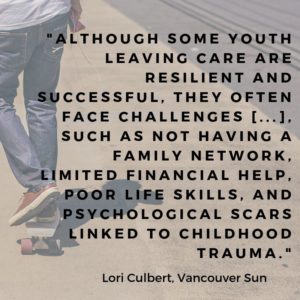
Although some youth leaving care are resilient and successful, they often face challenges […], such as not having a family network, limited financial help, poor life skills, and psychological scars linked to childhood trauma.
First of all, more consultation must be done with youth in care and who have aged out of care; they know what needs to be done. In fact, they are taking the lead in advocating for changes that would provide comprehensive, unconditional support for all young people leaving care until they are 24 years old. Alberta currently extends supports to former youth in care until the age of 24. Saskatchewan, Manitoba, and Ontario support youth financially until the age of 21.
At a minimum, advocates say AYA must be extended and available to all youth formerly in care. Analyses have shown that the cost-benefit ratio of supporting youth until their mid-twenties could be beneficial for the province’s bottom line, as well as for the individuals impacted by aging out.
There also needs to be more specialized support for youth who require it. LGBTQ2 youth will have different needs than youth in rural or remote areas, or who are women of colour, etc. Funding and programming should account for individualized support.
Some countries have implemented programs to provide a stable mentor through the aging out process. The Australian Lead Tenant program is a supportive housing program for young people who are leaving care, where live-in mentors guide the transition into independence. A wide-reaching program like this in BC would allow youth in care to learn life skills and prepare for independence. It would create opportunities for former youth in care to become mentors for their younger peers while securing housing and employment with MCFD. It would also increase access to supportive employment and housing programs, which we at Zero Ceiling have proven works for reducing youth homelessness.
Read: “From care to where? Aging out of the foster system” from the Vancouver Sun
Zero Ceiling Steps Up After Aging Out
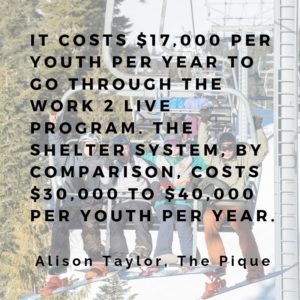
It costs $17,000 per youth per year to go through the Work 2 Live program. The shelter system, by comparison, costs $30,000 to $40,000 per youth per year.
Zero Ceiling has advocated on behalf of youth facing homelessness since 1997. We have educated ourselves and our community around the link between government care and aging out. We realized that early intervention is necessary to ensure young people don’t fall into lasting patterns of homelessness. Which is why we also accept youth who are at risk of becoming homeless through processes like aging out.
Many of our Adventure Sessions participants come to us from programs and agencies who serve children in care. As a group they come up to Whistler and join in a day of fun and adventure. They also get to see what we do at Zero Ceiling and meet some of our staff and volunteers. Some go on to apply to our other core program, Work 2 Live.
At least half of our Work 2 Live crew and graduates have been involved with care. We have become a transition program for many who have aged out on their 19th birthday. Some find themselves heading up to Whistler shortly after leaving their MCFD home. Through Work 2 Live, these young people get a stable, secure home with individualized care and support and opportunities for a fresh start. Our youth worker and staff work hard to give each crew member a true family.
In our community, we have gained a reputation for our efforts in raising awareness around the issues of youth homelessness. We advocate for our participants, and give them tools so that they can advocate for themselves. For over twenty years, education and amplification have been two of our guiding principles. And our community has become all the richer and more diverse for it.
Read: “Sky is the Limit for Zero Ceiling Grads” from The Pique Newsmagazine
There is no one-size-fits-all approach to improving our care system. However, it is clear that more needs to be done to support the people aging out of care so that they are given the chance to grow into independent, happy, and healthy people. We all deserve to feel loved and secure and to enjoy every birthday we get. Join us in our mission to provide supportive housing and employment to youth experiencing homelessness in Vancouver and the Sea-to-Sky corridor.
Read: “Fostering Truth: Breaking the Link Between Foster Care and Youth Homelessness” from HomelessHub.ca
If you are a young person transitioning into adulthood from government care, take a look at Aged Out, an online service that provides guides to topics such as how to get ID, how to go back to school, how to apply for financial assistance, and more. It is a great resource made for youth in care, by people who have been in your shoes.
#zeroceiling #iLiveOutside

